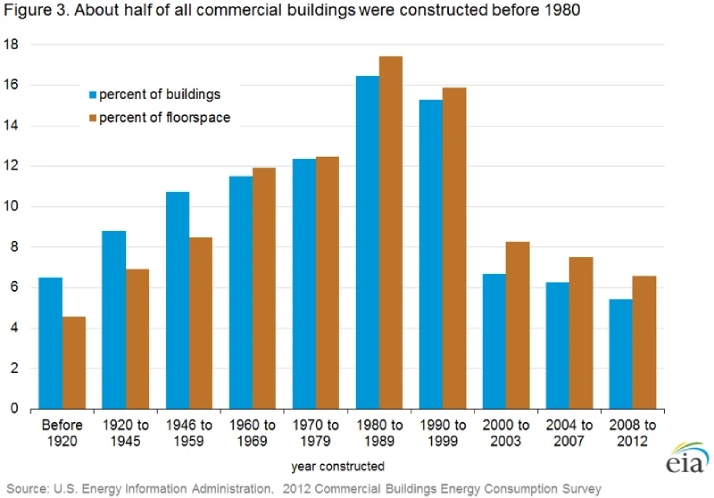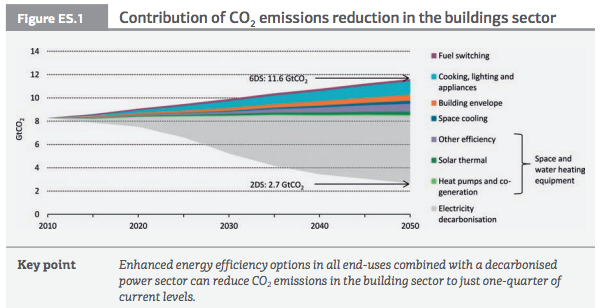According to the US Energy Information Administration, only 12% of the commercial buildings have been built since 2003 and more than half of them have been constructed before 1980 and the median age of buildings is around 32 years.

In the US, buildings consume 41% of the nation’s total energy usage through the use of HVAC, lighting, elevators etc. In major cities such as New York, San Francisco and Chicago, this number can be as high as 70%. As we are more and more focused on clean energy initiatives and our commitment to build a sustainable environment increases, it becomes imperative for most old buildings to take a look at the codes, standards, green-building initiatives as well as modern technologies to help achieve their energy goals.
Modern buildings implement sustainable design, adopt clean energy resources and use modern systems like IoT. This makes modern buildings very lucrative to potential tenants and leasers.
Addressing the need to retrofit old buildings comes with the challenge of investments, overhaul of the buildings (which can involve loss of revenue) and buying capital-intensive equipment.
This investment would be worthwhile if you understand the underlying reasons for modernizing these aging buildings. The other incentive would be the fact that most modernizing efforts leads to meeting larger business goals of saving costs and increasing tenant occupancy.
Here we will take a look at some of the reasons why it is essential to modernize aging buildings:
1. Energy efficiency goals: According to the Intergovernmental Panel on Climate Change (IPCC), “over the whole building stock, the largest portion of carbon savings by 2030 is in retrofitting existing buildings and replacing energy-using equipment”, and energy savings of 50 % to 75 % can be achieved in commercial buildings that make smart use of energy efficiency measures.
Since heating and cooling constitute the largest percentage of energy consumption, most old buildings lose energy due to the interiors and the unconditioned exterior. Retrofitting older buildings can help with a significant reduction in energy needed to heat or cool the building.
You can use ISO 16346:2013, which provides the necessary standards to calculate energy performance. These standards include thermal properties that envelope the building such as walls, roof and basement as well as the construction materials.
This will provide a good starting point to see if retrofitting the building will meet your energy efficiency goals.
2. Sustainable environment: Since buildings consume the largest amount of energy in the world, they also responsible for over one-third of the global carbon emissions. The International Energy Agency has laid out clear energy policies to create a sustainable environment and reduce poisonous emissions.
In case older buildings do not take any action, the optimal levels of emissions will raise due to the rapid increase in energy consumption. It is estimated that energy demand will increase over 50% by 2050. This increase will be detrimental to the global goal of limiting the global temperature raise to 2 degrees centigrade.
Older buildings can benefit by adopting a combination of tools and techniques to achieve this standard. This includes retrofitting the building envelope to optimize cooling and heating according to it’s geographical location and outside weather conditions. A high-performance building envelope in a cold climate requires just 20% to 30% of the energy required to heat the current average building in the Organization of Economic Co-operation and Development (OECD). In hot climates, the energy savings potential from reduced energy needs for cooling are estimated at between 10% and 40%.
Below is a table of energy efficiency options that can be considered while modernizing older buildings.

3. Modernization of technology: Older buildings often have older systems and processes such as separate building controls for every facility, isolated systems, outdated paper processes and manual collection of meter data. As more and more buildings are adopting “smarter” technologies or becoming smart buildings, architects, building owners, facility managers and builders are retrofitting older buildings with newer automation and control technologies.
A smart building is one, which uses automated control mechanisms, high-performing and integrated building technology. The Internet of things is creating new possibilities in automated building technology using low cost sensors. Smart building technology also enables real-time data visibility as well as advanced analytics. These can be used for continuous monitoring, remote controlling of equipment and systems such as HVAC, predictive analytics that can predict the energy consumption based on weather and many more functions that help with data-driven decisions.
If you think that retrofitting old buildings with smart building systems is expensive, you are mistaken. Cloud- computing technology and technologies like Internet of things (IoT) using low cost sensors, real-time analytics and sub metering have changed that misconception.
4. Competitive Position in the marketplace:
According to Lux Research, there is a huge co-relation between old buildings that have been modernized and rental rates and resale value. Their studies show that upgrading to the latest building standards and certifications helped build market demand for the buildings and the energy efficiency retrofits can create a much larger market opportunity.
It fuels growth and outperform their competition. For example, the report notes that higher rental income added $4.1 million in value to a modernized 80,000 ft2 commercial building in Los Angeles.
A recent study by Harvard’s T.H. Chan School of Public Health and United Technologies found that employee’s cognitive functions improved with better indoor environmental quality and ventilation. These included a 50 percent increase in focus, doubling in crisis response, and a tripling in information usage and strategic thinking scores. A follow-up study found positive impacts on sleep and wellness. Hence, organizations renting or leasing a building are more conscious of its influence on their productivity.
Modernizing your building will meet the tenant’s goals and not only increase the value of your property but also improve tenant retention and satisfaction.
5. Control/reduce operations and maintenance (O&M) expenses
On average, modern buildings offer lower operating costs than those with legacy systems. According to the McGraw Hill Construction Smart Market Report, modernized buildings with intelligent systems use 20% to 40% less energy and result in 8% to 9% lower operating expenses with valuations 7.5% higher than those with older systems.
Government subsidies for energy efficiency measures can also lead to an internal rate of return of 5–6 % over 15 years.
One of the best ways of retrofitting older buildings is to implement a software technology solution that causes least disruption to its operations.
By modernizing buildings with control systems, Building management systems and building automation systems, it gives the facility managers, building owners and operators extended visibility into the entire building. The control panels provide a single access point and equip everyone with visually pleasing dashboards of data.
The software can help you reduce the operations and maintenance expenses by implementing solutions such as:
- Detecting failed components in HVAC units before it causes a huge energy efficiency loss.
- Prevent facility managers and technicians from investigating false alarms by providing real-time monitoring information.
- Ability to set options that are not default and can be controlled remotely.
- HVAC and lighting adjustment according to the building’s occupancy.
- Visibility into energy waste as well as energy consumption at a granular level.
Conclusion:
In conclusion, older buildings have to invest resources in modernizing them due to multiple added benefits. Modernized buildings attract higher value tenants, meet their energy efficiency goals, reduce operating expenses and help in creating a sustainable environment.
By implementing a cloud based solution and smart systems you can achieve this at a lower cost of capital and high return on investment. This type of retrofits to the buildings can also be started small and has the ability to scale by adding more sensors and control systems. The ease of deployment of the modern systems can also cause least disruption to your building’s operation.
Employing these techniques to modern an aging building will present newer opportunities as well as bring you into the modern future.




